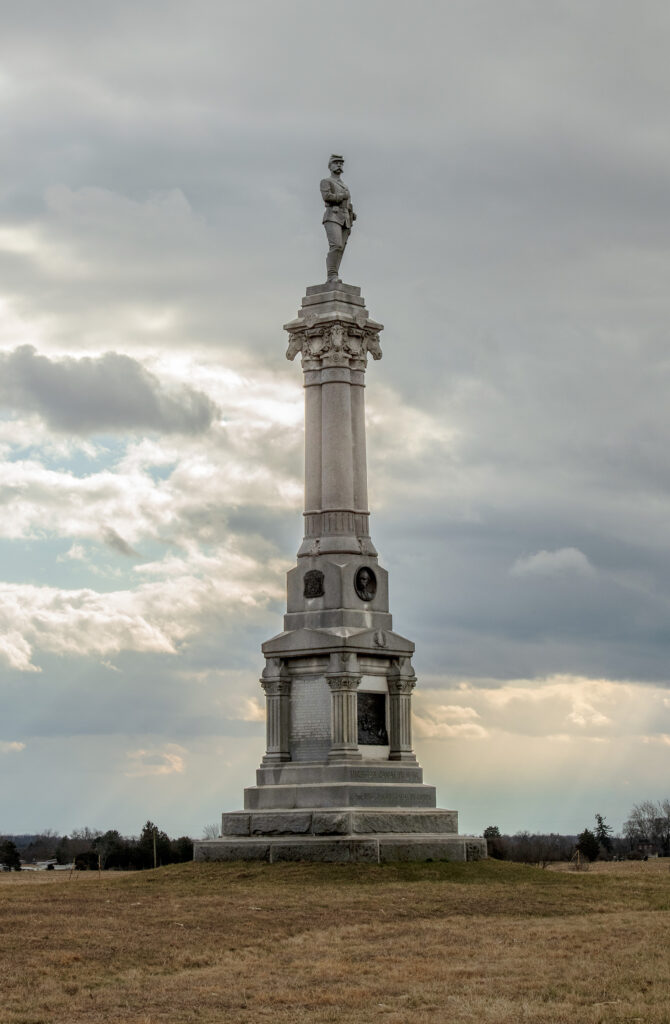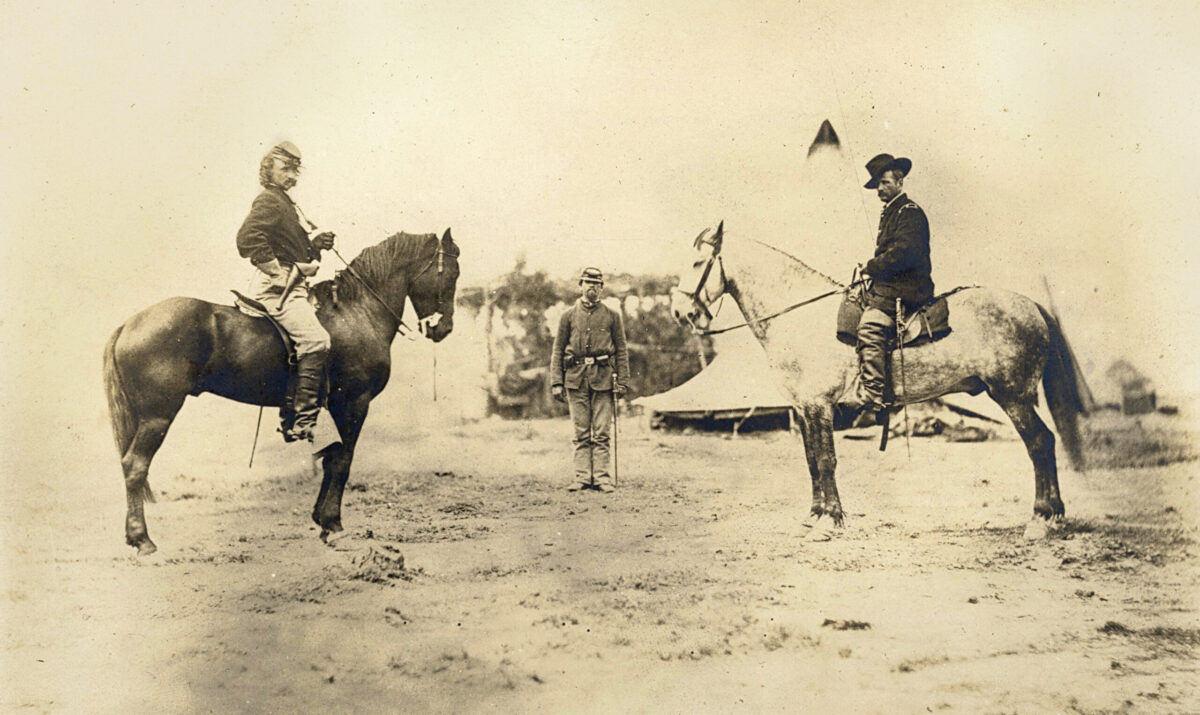The Army of the Potomac’s cavalry received a much-needed reorganization when Maj. Gen. Joseph Hooker assumed command of the Union’s largest army in the winter of 1863, transforming from a collection of mounted brigades to a formal Cavalry Corps. Most important perhaps, Hooker infused his horsemen with a new mission. Although they would continue fulfilling the traditional cavalry roles of scouting, picketing, headquarters security, and escort duty, they were now to serve primarily as an offensive weapon—much like J.E.B. Stuart’s vaunted troopers did in the Army of Northern Virginia.
During the Chancellorsville Campaign, Union cavalry performed better in defeat than it had in any previous campaign, but Hooker was disappointed in the leadership of some of its commanders, specifically corps commander George Stoneman and 2nd Division commander William A. Averell. Both lost their jobs in a further reorganization that followed Chancellorsville.
The Cavalry Corps’ new commander would be Maj. Gen. Alfred Pleasonton, known as a notorious self-promoter and miserable intelligence officer but someone Hooker believed might put more fire into his troopers. Pleasonton did. In the early stages of the Gettysburg Campaign in June 1863, the Federal horsemen took the fight to the Rebel cavalry at Brandy Station, Va., and in a subsequent series of sharply fought engagements at Aldie, Middleburg, and Upperville in central Virginia.
Nevertheless, though his men had fought well, Pleasonton was eager to find positions for his more aggressive subordinates. After Maj. Gen. Julius Stahel’s division was sent as reinforcements from the defenses of Washington, D.C., in late June, Pleasonton convinced the Army of the Potomac’s new commander, Maj. Gen. George G. Meade, to allow him to replace Stahel and his brigade commanders with officers of his own choice.
Pleasonton handed Stahel’s command to the recklessly aggressive Brig. Gen. H. Judson Kilpatrick, and to fill the two brigade slots he received approval to jump two junior officers—Elon Farnsworth and George Armstrong Custer—to brigadier general. Both men had been staff officers for Pleasonton and were favorites of the general.
Also elevated was Captain Wesley Merritt, who was handed a brigade in the cavalry’s 1st Division. All were young, bright, and aggressive officers.
Farnsworth never had a chance to prove himself, for he was killed July 3 at Gettysburg in a foolish attack demanded by Kilpatrick. Merritt proved an excellent soldier, but it is Custer we remember best. Because of the Little Big Horn showdown that lay in his future, Custer is remembered as a brash, ambitious, and particularly reckless officer. He was indeed brash and ambitious. His performance during the Gettysburg Campaign, however, showed an officer who understood modern cavalry tactics and applied them appropriately while displaying solid leadership commanding volunteers.
The 23-year-old Custer was, in fact, far more prudent than popular history would have us think. He asked for and received command of a brigade of four Michigan regiments: the 1st, 5th, 6th, and 7th. When he arrived in the camps of his brigade in the rain on June 29, Custer’s appearance instantly attracted attention—as he intended. A staff officer described him as “one of the funniest looking beings you ever saw, and looks like a circus rider gone mad! He wears a huzzar jacket and tight trousers, of faded black velvet trimmed with tarnished gold lace.” Not to mention a red cravat.
Ego partly drove Custer’s uniform style, but it also reflected his understanding of volunteer soldiers. They would recognize him instantly on the march or, more importantly, on the battlefield, where he intended to provide them leadership that would inspire them to risk their lives and take the fight to the enemy.
The day after assuming command of his brigade, June 30, Custer’s command engaged J.E.B. Stuart’s Confederate horsemen for the first time at Hanover, Pa. Instead of charging headlong into the fray, heedless of casualties, Custer demonstrated tactical competence, employing his superior firepower—the 5th and 6th Michigan carried Spencer repeaters—by dismounting his troopers and supporting them with attached horse artillery. The result was a check to the Rebel horsemen, who departed to find an easier route to reach Lee’s main army.

On July 2, Custer’s Michiganders encountered Brig. Gen. Wade Hampton’s veteran brigade near the small village of Hunterstown, Pa., several miles northeast of Gettysburg. When the officer leading Custer’s van emerged from the village, he encountered open ground extending west for several hundred yards. Standing partway across these open fields were two farms around which a small rearguard of Hampton’s Brigade had halted to keep the enemy at a distance from the main body.
Uncertain what this small body of enemy cavalry represented, Custer dismounted several companies of the 6th Michigan and unlimbered his horse artillery to provide covering fire. But to disperse the Confederate horsemen, he ordered Company A of the 6th to conduct a mounted charge. Then, as the company readied for its advance, Custer drew his saber and motioned for his staff to stay back before riding out in front of the troopers. With what would be described as a “careless laughing remark,” he declared, “I’ll lead you this time boys. Come on!’”
The charge struck the Confederates hard. Reinforcements from Hampton’s Brigade counterattacked and a wild melee ensued. Custer’s horse was killed beneath him, and he was almost ridden down and killed by a Southern trooper—his life saved by his orderly, who dropped the assailant with a well-aimed shot.
Custer’s prudence in establishing an additional line of fire was rewarded when his dismounted troopers and horse artillery held off Hampton’s counterattack. Though Custer had taken an unnecessary risk in leading the charge, the calculated risk paid dividends in increased confidence and respect for the young general’s leadership.
A day later, Custer made even more of a mark with his men and the army in the much larger cavalry action three miles east of Gettysburg around the John Rummel Farm. Again, Custer displayed a firm grasp of cavalry tactics, skillfully using his troopers in both dismounted and mounted roles, and establishing his horse artillery as a base of fire. And again, Custer deliberately placed himself in harm’s way by leading charges by the 7th and then the 1st Michigan Cavalry. In both charges he rode out in front of his men shouting, “Come on, you Wolverines!” The result was a block of Stuart’s efforts to disrupt the Army of the Potomac’s communication lines.
Custer had accomplished precisely what Pleasonton had sought in advancing these young men to brigade command. It elevated the Union cavalry to the level of J.E.B. Stuart’s. That process had actually begun a few weeks earlier at Brandy Station, but now the Army of the Potomac’s horsemen would be an effective fighting arm. The attrition of two more years of war meant that the men in blue would, however, gradually gain superiority.
Scott Hartwig writes from the crossroads of Gettysburg.






